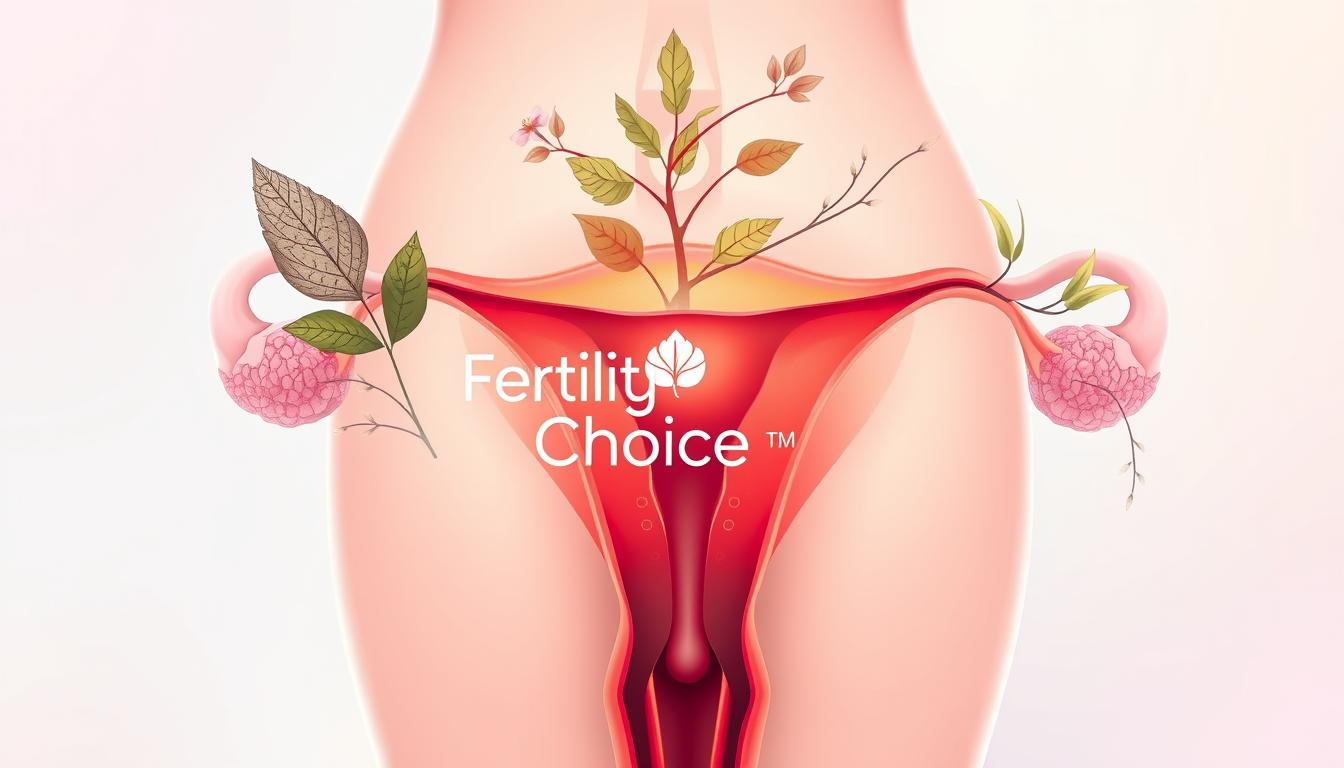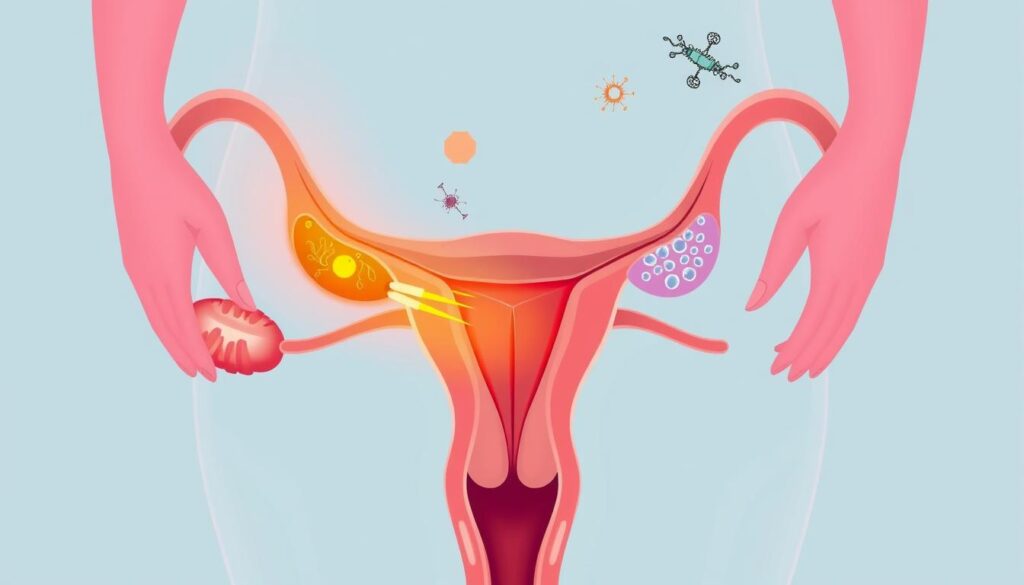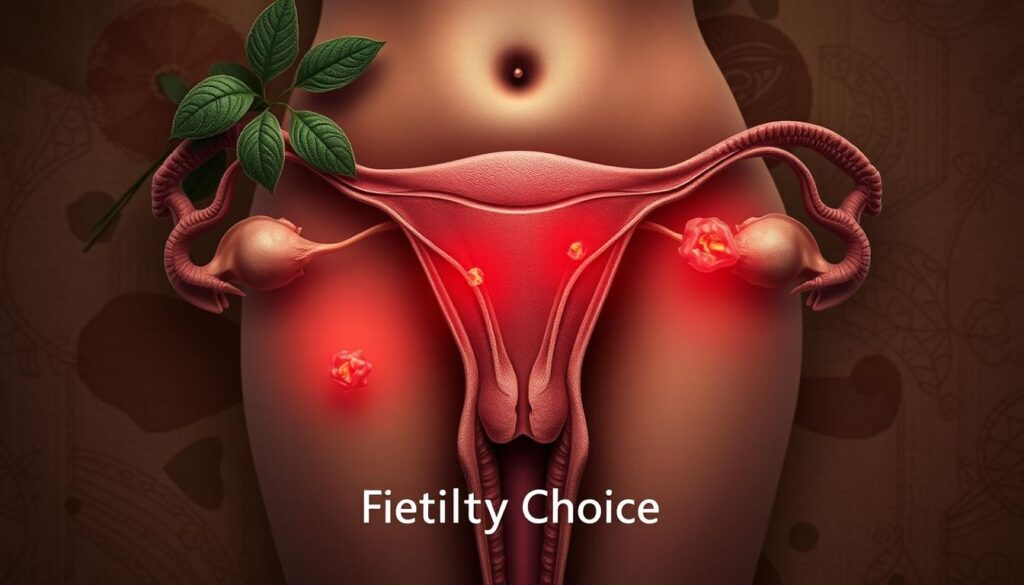
Endometriosis is a chronic condition that affects the reproductive system. It causes severe pain and infertility, which is a type of inflammatory pelvic disease and reproductive system infection1. In North America, about 5.5 million women suffer from endometriosis, making it a major cause of infertility2.
In South Africa, women with endometriosis may find it hard to conceive. Pregnancy rates are lower for those with severe endometriosis2. Endometriosis can also damage the fallopian tubes, affecting fertility2. Women who have surgery for endometriosis face a higher risk of placenta previa, with a 10-20% chance1.
Women over 35 face higher risks of fertility issues and miscarriage1. A fertility specialist might suggest an anti-mullerian hormone (AMH) test to check ovarian reserve. Normal AMH levels suggest better fertility chances1. For women with mild endometriosis, superovulation and intrauterine insemination (SO-IUI) can be effective. Success rates vary but can be up to 20%1.
Endometritis is a condition where the uterus gets inflamed. This can cause fertility problems and other health issues4. It often happens after a miscarriage or childbirth, like after a C-section. About 11% of women get endometritis after a vaginal delivery, and up to 27% after a C-section4.
Bacterial infections are a main cause of endometritis. If not treated, it can lead to serious problems like infertility, pelvic peritonitis, and septicemia5.
Symptoms include swelling in the abdomen, abnormal bleeding or discharge, pain in the lower abdomen, fever, and discomfort when moving the bowels4. If these symptoms show up after childbirth, miscarriage, or uterine surgery, it’s important to see a doctor right away. Early treatment can stop serious problems5.
Here are some common symptoms and complications of endometritis:
Antibiotics are the main treatment for endometritis. It’s important to finish the whole treatment to avoid more problems4. Knowing the causes and symptoms of endometritis helps women protect their reproductive health and avoid fertility issues5.
| Symptom | Description |
|---|---|
| Abdominal swelling | Pain and discomfort in the lower abdomen |
| Abnormal vaginal bleeding | Unusual bleeding or discharge from the vagina |
| Fever | High body temperature, often accompanied by chills |
Diagnosing endometritis can be tricky, but it’s key for treating the condition. Pelvic pain is a common symptom, and antibiotics are often needed to fight the infection. If the infection persists, it can lead to more serious problems.
To diagnose endometritis, doctors use a mix of physical exams, medical history, and tests. Laparoscopy and hysteroscopy help see the uterus and nearby tissues. An endometrial biopsy takes a sample from the uterus lining for closer look6. Studies show endometritis affects about 1-2% of women after a normal vaginal delivery. This number goes up to 5-6% for those with certain risk factors6.
These methods let doctors see the uterus and nearby areas. They help spot any issues or infections. Sometimes, laparoscopy and hysteroscopy are used with other tests like ultrasound or MRI to confirm endometritis7.
This test takes a sample from the uterus lining to check for infection or inflammation. It’s a crucial tool for diagnosing endometritis. It helps find the infection’s cause and guides treatment6.
Endometritis is a reproductive system infection that can harm fertility if not treated. It’s a gynecological condition needing quick medical care. Treatment often includes antibiotics to fight bacterial infections8. Probiotics and lifestyle changes can also help, lowering fertility risks7.
Research shows antibiotics can cut postpartum endometritis risk by half in cesarean births8. Single-dose gentamicin works as well as multi-drug regimens in some cases8. It’s vital to see a doctor if symptoms appear, as delayed treatment can cause serious problems7.
Some key treatments for endometritis include:

Effective treatments, like gentamicin and clindamycin, resolve postpartum endometritis in 80-90% of cases8. It’s important to get a healthcare provider’s advice on the best treatment for endometritis. This condition can greatly affect reproductive health7.
| Treatment Option | Effectiveness |
|---|---|
| Antibiotic therapy | Highly effective in combating bacterial infections8 |
| Probiotics | Helps maintain a healthy balance of gut bacteria7 |
| Lifestyle changes | Reduces the risk of fertility complications7 |
Endometritis is an inflammatory pelvic disease that can harm fertility. It causes uterine inflammation and can make it hard to get pregnant9. It’s crucial to treat endometritis to boost fertility chances10.
Research shows that chronic endometritis often has no symptoms. This makes it a hidden problem for women trying to conceive naturally9. Treating it involves antibiotics, which is key to managing it well9. Studies find that 2.8% to 30% of infertile patients have chronic endometritis10.
Managing endometritis to improve fertility involves:
By understanding endometritis’s impact on fertility and managing it, women can lower their risk of fertility issues. This can help them have a successful pregnancy10.
Chronic endometritis is a common gynecological issue that causes pelvic pain and infertility11. It often leads to repeated miscarriages and implantation failures11. For women trying to get pregnant, treating this condition is crucial11. A healthy endometrium is key for embryo implantation, needing at least 8mm thickness11.
To diagnose chronic endometritis, doctors use hysteroscopy and endometrial biopsy11. They look for CD138 cell markers11. The first treatment is a two-week course of antibiotics, with probiotics to balance bacteria11. Research shows this treatment can improve fertility11.
Some important facts about chronic endometritis are:
Antibiotics are often needed to treat chronic endometritis11. It’s important to check if the inflammation has gone away11. Treating this condition can help women get pregnant and reduce pelvic pain11.
Endometritis is a reproductive system infection that can affect fertility. It’s a big gynecological issue. Managing it well is key to avoiding long-term fertility problems and keeping overall health good8.
Managing endometritis means dealing with pain and using hormones. Hormones like progesterone help control the menstrual cycle. They also lower the chance of fertility issues13.
Managing pain is vital in treating endometritis. It makes symptoms better and improves life quality. Hormones, like progesterone, also help. They make the menstrual cycle regular and cut down on fertility problems13.
Hormonal treatments, like progesterone, are very helpful. They make the menstrual cycle steady and lower fertility risks. These treatments also ease symptoms like heavy bleeding and cramps13.
| Treatment Options | Benefits |
|---|---|
| Pain Management | Alleviates symptoms, improves quality of life |
| Hormonal Treatments | Regulates menstrual cycle, reduces fertility complications |

Working with a healthcare provider and sticking to a treatment plan helps manage endometritis. This approach reduces fertility risks. It also boosts overall health and well-being813.
Women with symptoms of endometritis should see a doctor quickly. This is because it can cause inflammatory pelvic disease and uterine inflammation, leading to fertility complications14. If not treated on time, it might make it harder to have children, affecting about 10% of cases14. Also, chronic endometritis can cause fertility problems in 20-30% of cases14.
It’s important to use condoms to avoid STIs. One in five people will get an STI at some point14. Medical procedures like hysteroscopy and IUD placement can also increase the risk of infection14. But, getting treatment early can help a lot, with over 90% of cases getting better with antibiotics14.
Early treatment has many benefits:
Managing endometritis needs a whole-body approach. This includes making lifestyle changes to ease symptoms like pelvic pain. A big part of this is changing what we eat. For example, a study showed that 75% of women with endometriosis felt less pain after avoiding gluten15. Also, eating more plants can lower the risk of getting endometriosis16.
Exercise is also key in managing endometritis. It helps lower estrogen and releases feel-good hormones, easing pain15. Stress-reducing activities like meditation and yoga can also help. It’s important to remember that drinking too much alcohol can increase the risk of endometriosis16.
Other lifestyle changes include getting enough sleep, keeping clean, and avoiding things that make symptoms worse. By making these changes, people can handle their endometritis better and avoid long-term problems. A balanced diet is crucial, as high trans fat intake is linked to more endometriosis cases15.
In summary, lifestyle changes are vital for managing endometritis and easing symptoms like pelvic pain. By choosing the right foods, exercising regularly, and managing stress, people can lower their risk of chronic infection. Studies show that a low-FODMAP diet and supplements can greatly help symptoms15. Regular exercise can also help by lowering estrogen levels16. These changes are essential for managing endometritis.
Women with endometritis often look for ways to ease their symptoms. Acupuncture is one option that can help reduce pain and improve well-being17. Herbal remedies like curcumin and chamomile also have anti-inflammatory effects, which can help manage endometritis17.
Mind-body therapies, including meditation and yoga, are great for stress relief. They help women with endometritis relax and manage their condition18. Eating well and exercising regularly can also boost reproductive health and reduce fertility issues19. Treatments like osteopathy and chiropractic care focus on fixing musculoskeletal issues to ease pain and aid healing18.
It’s crucial for women with endometritis to talk to their doctor before trying alternative therapies. Some treatments might not work well with standard care or could cause problems19. By exploring these options and making healthy lifestyle choices, women can improve their quality of life and manage their symptoms better.
| Alternative Therapy | Potential Benefits |
|---|---|
| Acupuncture | Pain reduction, improved well-being |
| Herbal Remedies | Anti-inflammatory properties, reduced symptom severity |
| Mind-Body Therapies | Stress reduction, improved relaxation |
Research on inflammatory pelvic disease has improved our understanding of its effects on uterine inflammation and fertility issues20. In South Africa, about 10-11% of people suffer from chronic endometritis20. Also, 3-10% of those with abnormal uterine bleeding have this condition20.
New treatments and diagnostic tools are being explored to tackle uterine inflammation and fertility problems21. A study found chronic endometritis in 14% to 67.5% of patients with recurrent implantation failure21. Another study showed it affects 40.7% of those with abnormal uterine bleeding21.
A table summarizing the prevalence of chronic endometritis in different populations is as follows:
| Population | Prevalence of Chronic Endometritis |
|---|---|
| General population | 10-11%20 |
| Patients with abnormal uterine bleeding | 3-10%20 |
| Patients with recurrent implantation failure | 14% to 67.5%21 |
These findings show how crucial it is to tackle inflammatory pelvic disease and uterine inflammation to prevent fertility issues20. As research progresses, it’s vital to keep up with the latest in diagnosing and treating chronic endometritis21.
In conclusion, endometritis is a22 significant23 gynecological condition. It can deeply affect women’s fertility and reproductive health. Understanding its causes, symptoms, and treatment is key for both patients and healthcare providers.
Early diagnosis and prompt22 antibiotic treatment are vital. They can greatly improve outcomes. For example, timely prophylaxis can lead to an 85% reduction in postcesarean infections.
Lifestyle changes, like avoiding douching, can also help. By addressing the causes and using effective management strategies, healthcare providers can help women. This can improve their chances of a successful pregnancy.
– Endometritis is a common22236 gynecological condition. It can significantly impact women’s fertility and overall reproductive health.
– Early diagnosis and prompt22 antibiotic treatment are crucial for managing endometritis and improving outcomes.
– Lifestyle changes, such as avoiding douching, can help reduce the risk of developing endometritis.
– Addressing the underlying causes and implementing effective management strategies are key to overcoming the challenges posed by endometritis.
Raising awareness and promoting a better understanding of endometritis is crucial. It empowers women to seek timely medical attention. Working together with healthcare providers can lead to improved fertility outcomes and better reproductive health for women in South Africa and beyond22236.
Stay Connected and Get Personalized Assistance
Thank you for reading! We hope you found this post helpful and informative. If you have any questions or need further assistance, please reach out. We’re here to help you on your journey
